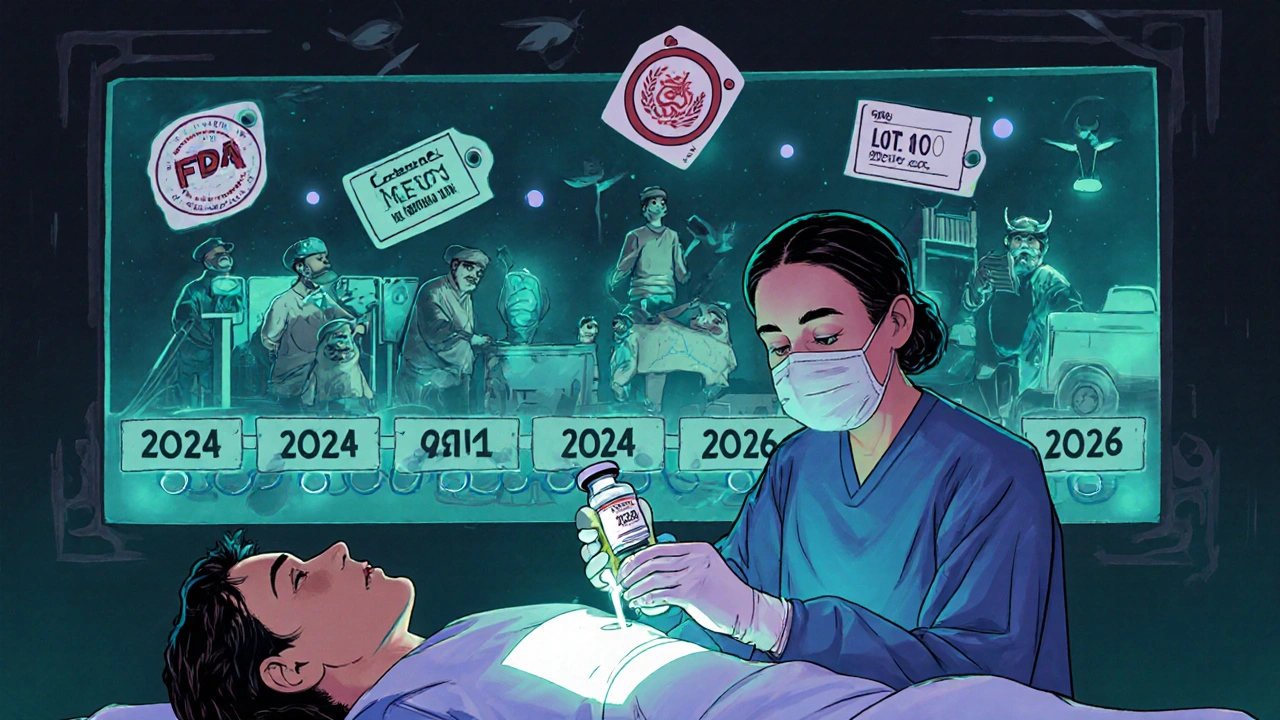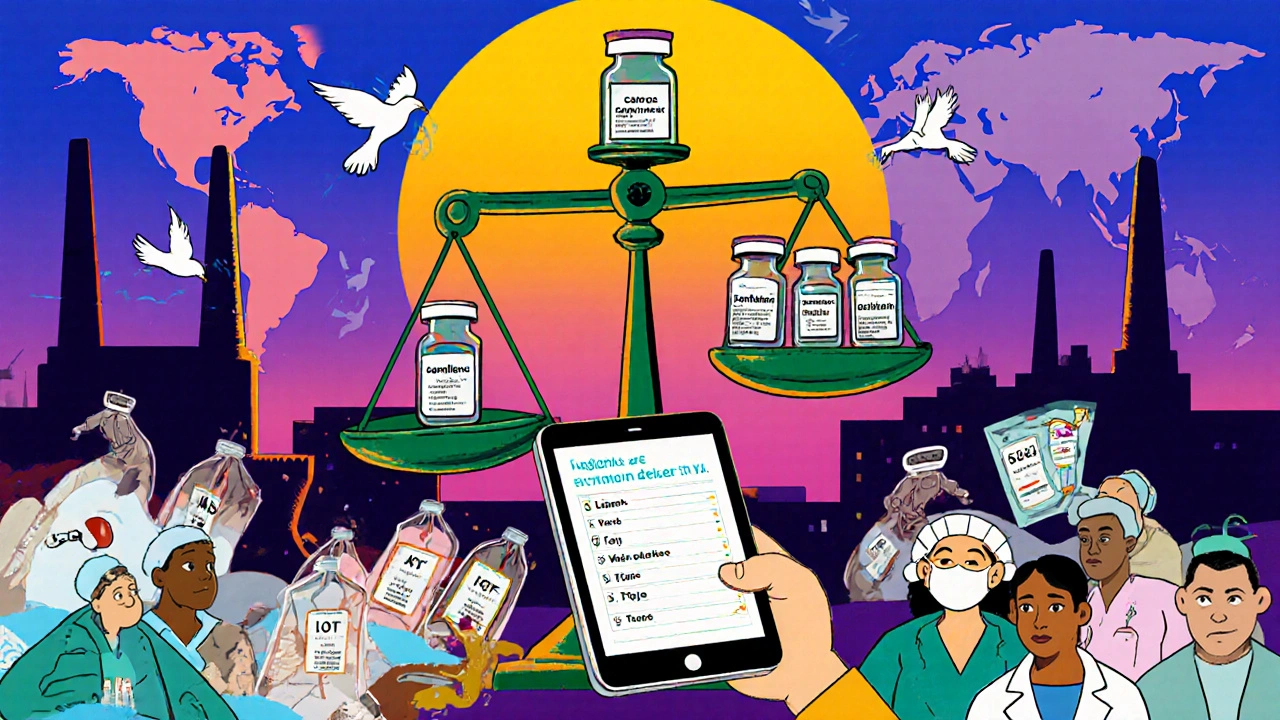When a life-saving drug runs out, hospitals don’t just wait for more to arrive. In the U.S., the FDA steps in with a quiet but powerful tool: extending the expiration dates of existing stock. This isn’t a loophole or a gamble. It’s a science-backed, tightly controlled process that keeps patients alive when supply chains break down.
Why expiration dates get extended
Expiration dates aren’t magic dates when drugs suddenly turn toxic. They’re the last day the manufacturer guarantees the drug will work exactly as labeled-based on stability testing done under controlled conditions. But many drugs remain safe and effective long after that date. The FDA allows extensions only when manufacturers provide solid data proving the drug still meets quality standards: identity, strength, purity, and potency.
This isn’t done for every drug on the shortage list. Only critical medications qualify. Think epinephrine for anaphylaxis, propofol for anesthesia, or IV fluids during surgery. If there’s no safe alternative, and the supply is critically low, the FDA reviews stability data and may approve an extension-often adding one year. In extreme cases, like the 2024 IV solution shortage, some batches were approved for use up to 24 months after manufacture.
How the FDA decides
The process starts with manufacturers. Under the Food and Drug Administration Safety and Innovation Act (FDASIA) of 2012, companies must tell the FDA early if they plan to stop making a drug or if production is falling behind. This gives the agency time to act before a crisis hits.
Once a shortage is confirmed, the manufacturer submits long-term stability data to the FDA. This isn’t a quick scan-it’s months or years of real-world testing showing the drug hasn’t degraded. The FDA’s team in the Center for Drug Evaluation and Research (CDER) reviews it. If the data holds up, they approve an extension. No relabeling is required. Instead, the FDA publishes a public list with exact lot numbers, NDC codes, and new use dates.
For example, in October 2024, the FDA extended the expiration date of Hospira’s Meperidine hydrochloride injection (Lot HN8657) from September 30, 2025, to January 30, 2026. Another lot of Dantrolene sodium got a 6- to 9-month extension. These aren’t blanket changes. Each lot is tracked individually. Pharmacies must check the FDA’s list before using any extended-date product.

What drugs are most often extended
Not all drugs are created equal when it comes to expiration extensions. Propofol injection leads the list by a wide margin. It’s used in nearly every operating room for sedation. Without it, surgeries stall. Epinephrine injections come next. Used in emergency rooms for allergic reactions, there’s no real substitute. Other common candidates include IV fluids like saline and dextrose, especially during supply crunches, and antivirals like Tamiflu during flu surges.
The FDA’s approach is selective. A 2021 analysis by Lachman Consultants found that the word “critical” is key. If a drug is essential, has no alternatives, and stability data supports it, the FDA acts. If it’s a non-essential medication with plenty of supply, even if it’s in shortage, it won’t get an extension.
What hospitals and pharmacies must do
Getting an extension doesn’t mean you can just grab any bottle off the shelf. Healthcare providers must verify the exact lot number against the FDA’s published list. The agency doesn’t require relabeling, so a vial might still show the original expiration date. That’s why pharmacies need updated inventory systems and staff training.
Imagine a hospital pharmacy with three boxes of propofol: one with an original expiration date of June 2025, another extended to June 2026, and a third with no extension. Staff must know which is which. Administering a drug past its true expiration date-even if it looks fine-can be dangerous. The FDA’s list is the only official guide.
The American Hospital Association and the American Medical Association both direct providers to the FDA’s Drug Shortages Database and mobile app. These tools help hospitals track which lots are safe to use and when new supplies are expected.

What the FDA doesn’t do
The FDA doesn’t regulate how doctors prescribe. If a drug is in shortage and an extension is in place, the agency won’t tell a hospital which alternative to use. That’s up to the clinician. They must consider patient history, allergies, and clinical guidelines.
The FDA also doesn’t fix the root causes of shortages. That’s the hard part. Many critical drugs are made by just one or two manufacturers. If a factory has a quality issue, or a key ingredient is delayed overseas, production halts. The FDA can help by speeding up inspections or finding backup suppliers, but they can’t force a company to make more.
Expiration extensions are a bandage, not a cure. They buy time-usually until new production lines are up and running. The FDA expects hospitals to replace extended-date stock as soon as new shipments arrive. Used vials should be properly disposed of, not hoarded.
The bigger picture
Drug shortages aren’t new, but they’ve gotten more frequent and severe. The pandemic exposed how fragile global supply chains are. Even after demand stabilized, manufacturing delays lingered. In December 2024, the FDA even added empty IV bags to its Medical Device Shortages List-a sign that the problem isn’t just about the drugs themselves, but the packaging and delivery systems too.
As of November 2025, the FDA’s Drug Shortages Database lists 343 products with extended expiration dates. That’s more than ever before. It shows how heavily the system is relying on this tool. But it also highlights a deeper problem: too many essential drugs are made in single-source facilities with little redundancy.
The FDA’s extension program is smart, safe, and necessary. But it shouldn’t be the only solution. Long-term fixes need better manufacturing diversity, more transparent supply chains, and incentives for companies to keep producing critical drugs-even when profit margins are thin.
For now, patients and providers can trust that when a drug’s expiration date is extended by the FDA, it’s not a guess. It’s science. It’s data. And it’s the difference between getting treatment-and not getting it at all.
Can I use a drug past its printed expiration date if it’s on the FDA’s extended list?
Only if the exact lot number is listed on the FDA’s official extended use dates table. The printed expiration date on the bottle or vial may be outdated. You must check the FDA’s database using the NDC code and lot number to confirm the new use date. Never assume a drug is safe to use past its printed date unless it’s confirmed on the official list.
Are extended expiration dates safe?
Yes, when approved by the FDA. Manufacturers must provide rigorous stability data showing the drug maintains its identity, strength, purity, and potency over the extended period. The FDA reviews this data independently before granting approval. These extensions are based on real-world testing, not assumptions. The agency has used this method for decades with no evidence of harm when followed correctly.
Does the FDA require pharmacies to relabel drugs with extended expiration dates?
No, the FDA does not require or recommend relabeling. The original packaging stays as-is. Instead, the FDA publishes a public list with the extended dates for each specific lot. Pharmacies and hospitals must maintain internal records matching the lot numbers to the new use dates. This avoids confusion and ensures only approved lots are used.
How long do FDA expiration extensions usually last?
Most extensions add one year to the original expiration date. However, the length varies based on the stability data submitted. In the 2024 IV fluid shortage, some Baxter products received extensions of up to 24 months. For other drugs like Dantrolene, extensions were 6-9 months. The FDA approves the exact duration based on the data-not a fixed rule.
Why aren’t all drugs in shortage eligible for expiration extensions?
Only drugs that meet two criteria qualify: they must be considered critical (no safe or effective alternatives exist), and the manufacturer must provide high-quality stability data proving the drug remains effective and safe beyond its original date. Many drugs in shortage are non-essential or have plenty of substitutes, so extensions aren’t needed. The FDA prioritizes life-saving medications.
Where can I find the official list of drugs with extended expiration dates?
The FDA publishes the official list on its Drug Shortages page, updated daily. It includes the drug name, manufacturer, NDC code, lot numbers, original expiration date, and extended use date. The list is searchable and also available through the FDA’s Drug Shortages mobile app. Always use this official source-never rely on third-party websites or internal hospital lists without cross-checking.


Comments (10)
Rodney Keats
So let me get this straight-we’re giving hospitals permission to use expired drugs because the pharma industry can’t make enough? 🤡 Guess I should’ve majored in corporate lobbying instead of biology.
Laura-Jade Vaughan
This is actually 🤯 so fascinating. The FDA’s data-driven approach to extending expirations is a quiet hero in healthcare. Propofol extensions? YES. IV fluids? ABSOLUTELY. It’s science, not speculation. 🙌 We need more of this kind of intelligent crisis management. #PharmaTransparency
Jennifer Stephenson
Lot numbers matter. Check the list. Don’t guess.
Philip Rindom
Yeah, I’ve seen this in action. My hospital used extended propofol last winter. Staff had to cross-check every vial. Annoying? Sure. Safer than running out? Absolutely. 😅
Jess Redfearn
Wait, so if I find an old epinephrine pen in my glovebox from 2022, can I just check the FDA list and use it? Asking for a friend… who’s also me.
Ashley B
This is all a cover-up. The FDA doesn’t test anything. They just rubber-stamp whatever Big Pharma gives them. The real reason drugs expire? Because they’re designed to. Planned obsolescence. You think they care if you live? They care about your insurance co-pay. 💉🩸
Scott Walker
As a Canadian, I’m impressed. We don’t have this system. We just wait… and wait… and wait. The FDA’s transparency here is actually kind of beautiful. 🇺🇸❤️
Sharon Campbell
who even cares about expiration dates anymore? everything’s fine till it’s not. and then you just get a new one. lol
sara styles
You think this is safe? You think the FDA has the resources to properly test every single lot? They’re understaffed, underfunded, and pressured by corporate lobbyists. The stability data? Half of it’s extrapolated from accelerated aging tests that don’t reflect real-world storage. And don’t get me started on how some of these drugs sit in warehouses for months before they even get to the hospital. Heat. Humidity. Light. They’re not lab samples-they’re sitting in a truck in Texas in July. This isn’t science. It’s a gamble with your life. And you’re just going to trust a list? Wake up. This system is broken and you’re being lied to.
Brendan Peterson
There’s a nuance here that’s being missed. The FDA doesn’t extend dates arbitrarily. The manufacturer must have submitted real-time stability data from a validated protocol-often over multiple years. It’s not a guess. It’s a regulatory process with documented standards. The problem isn’t the extension-it’s the lack of manufacturing redundancy. Fix the supply chain, not the label.